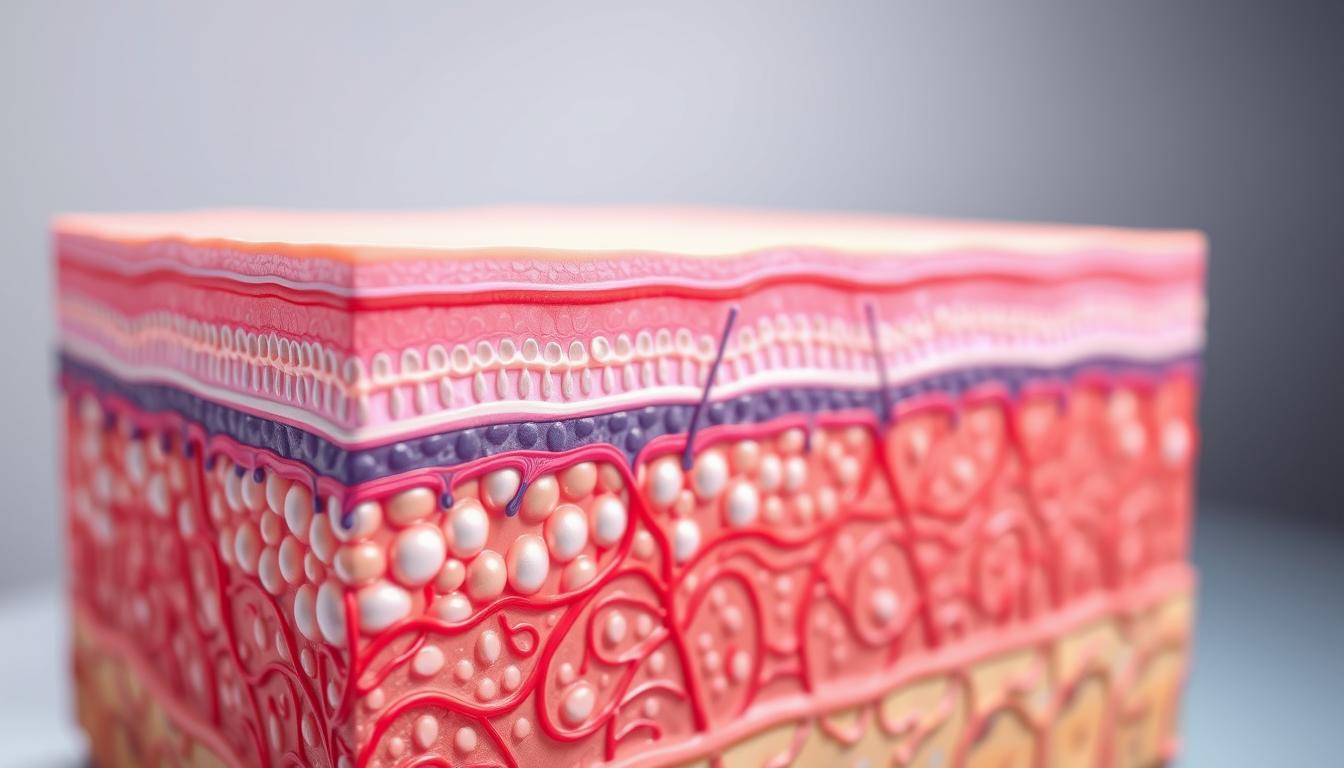Did you know your skin covers approximately 2 m² of your body1? This vast surface is your first line of defense against environmental aggressors. Maintaining a healthy skin barrier is crucial for overall skin health and protection.
Plant oils have been used for centuries to support skin health. Their anti-inflammatory and antioxidant properties help repair the stratum corneum and maintain skin homeostasis1. Today, advanced skincare formulations combine these traditional ingredients with modern science.
Ceramides and postbiotics work together to enhance the skin barrier. This synergy improves hydration, reduces irritation, and strengthens the skin’s natural defenses. Understanding how these components interact can help you achieve healthier, more resilient skin.
This article will explore the science behind ceramides and postbiotics. You’ll also find practical tips for optimizing your skincare routine. Stay tuned for insights that can transform your approach to skin health.
Key Takeaways
- Your skin covers a large area and acts as a protective barrier.
- Plant oils have long been used for their skin benefits.
- Ceramides and postbiotics work synergistically to improve skin health.
- A healthy skin barrier protects against environmental damage.
- Advanced skincare combines traditional ingredients with modern science.
- Scientific research supports the use of ceramides and postbiotics.
- Practical tips can help optimize your skincare routine.
Introduction to Modern Skin Barrier Restoration
Your skin’s health is directly tied to its ability to protect and restore itself. A strong, resilient skin surface is essential for shielding your body from environmental stressors. Modern skincare focuses on enhancing this natural defense system.
Understanding the Importance of a Healthy Skin Barrier
The barrier function of your skin relies on three key components: physical, chemical, and immunological. Together, they create a shield that locks in moisture and keeps out irritants. When this system is compromised, issues like dryness and sensitivity can arise.
Advanced ingredients are changing the game. For example, ceramides and postbiotics work together to strengthen the skin’s natural defenses. These components not only improve hydration but also reduce irritation and inflammation2.
Overview of Advanced Skincare Concepts
Modern formulations often include fatty acids, which play a crucial role in maintaining barrier integrity. These acids help replenish the lipid matrix, ensuring your skin stays hydrated and supple3.
“The right ingredients can transform your skincare routine,” says a leading dermatologist. By incorporating scientifically-backed components, you can achieve healthier, more resilient skin.
Stay tuned as we delve deeper into the structural and functional aspects of skin health in the next sections.
Understanding the Structure and Function of the Skin Barrier
Your skin’s outermost layer plays a vital role in keeping you protected. Known as the stratum corneum, it acts like a shield against environmental stressors. This layer is often compared to a brick wall, where corneocytes are the bricks and lipids act as the mortar4.
Anatomy of the Stratum Corneum and Its Lipid Matrix
The stratum corneum is made up of corneocytes, which are flat, dead skin cells. These cells are surrounded by a lipid matrix that includes ceramides, cholesterol, and fatty acids. Together, they create a protective barrier that locks in moisture and keeps out irritants4.
Ceramides are particularly important. They make up about 50% of the lipids in this layer and play a key role in moisture retention. Without enough ceramides, your skin can become dry and prone to irritation5.
The lipid matrix also influences the overall effect on your skin’s resilience. A healthy matrix ensures your skin stays hydrated and supple, while a compromised one can lead to issues like sensitivity and flakiness4.
Understanding this structure helps you see why maintaining a strong outer layer is so important. In the next sections, we’ll explore how topical ingredients can support and restore this essential part of your skin.
Ceramides: The Cornerstone of Skin Repair
Ceramides are essential lipids that play a critical role in maintaining your skin’s health. These naturally occurring molecules are fundamental to keeping your skin hydrated and protected. Without them, your skin can become dry, irritated, and prone to damage6.
Role of Ceramides in Moisture Retention and Barrier Integrity
Ceramides help lock in moisture by forming a protective layer on your skin’s surface. They make up about 50% of the lipids in the stratum corneum, ensuring your skin stays hydrated and supple7. This lipid matrix acts like a mortar, holding skin cells together and preventing water loss.
When ceramide levels are low, your skin’s function can be compromised. This leads to dryness, flakiness, and increased sensitivity. Maintaining adequate ceramide levels is crucial for a healthy, resilient outer layer6.
How Topical Ceramide Products Restore Barrier Function
Topical products containing ceramides are formulated to replenish these essential lipids. These formulations often include other beneficial ingredients like fatty acids and cholesterol to enhance their effectiveness7.
“Ceramide-enriched products are a game-changer for restoring skin health,” says a leading dermatologist. Clinical studies show that these products improve hydration, reduce irritation, and strengthen the skin’s natural defenses6.
| Benefit | Effect |
|---|---|
| Moisture Retention | Locks in hydration, preventing dryness |
| Barrier Integrity | Strengthens the skin’s protective layer |
| Reduced Irritation | Calms sensitive skin and reduces redness |
By incorporating ceramide-based products into your routine, you can support your skin’s natural repair processes. These formulations are designed to deliver ceramides effectively, ensuring optimal results7.
Postbiotics: Their Role in Soothing Inflammation
Postbiotics are gaining attention for their ability to calm and restore your skin’s natural balance. Unlike probiotics, which are live bacteria, postbiotics are the beneficial byproducts produced during the fermentation process. These compounds are known for their ability to soothe irritation and support a healthy microbiome7.
Benefits of Postbiotic Ingredients in Skincare
Postbiotics offer a range of benefits for your skin. They help reduce redness and irritation by calming inflammatory responses. Studies show that certain postbiotics, like Lactobacillus paracasei, inhibit substance P, which decreases inflammation and sebaceous activity7.
These ingredients also play a key role in restoring a balanced skin composition. By promoting a healthy microbiome, postbiotics help your skin maintain its natural defenses. This makes them an excellent addition to skincare routines focused on repair and resilience8.
“Postbiotics are a game-changer for sensitive skin,” says a leading dermatologist. Their ability to reduce irritation and strengthen the skin’s natural barrier makes them a valuable tool in modern skincare.
| Benefit | Effect |
|---|---|
| Reduced Inflammation | Calms redness and irritation |
| Microbiome Support | Promotes a balanced skin environment |
| Barrier Enhancement | Strengthens natural defenses |
Scientific research highlights the effectiveness of postbiotics in topical applications. For example, a study using Lactobacillus plantarum showed a reduction in acne count and associated erythema8. These findings underscore their potential in addressing skin concerns.
When combined with ceramides, postbiotics create a powerful synergy. While ceramides restore moisture and strengthen the lipid matrix, postbiotics calm inflammation and support the microbiome. Together, they provide a comprehensive approach to skin health7.
Barrier Repair 2.0: The Ceramide and Postbiotic Synergy in Modern Skincare
Combining ceramides with postbiotics creates a powerful duo for skin health. These ingredients work together to target multiple levels of skin repair, enhancing its natural defenses. By replenishing essential lipids and calming irritation, they provide a comprehensive approach to maintaining a healthy outer layer9.
Ceramides are key to restoring moisture and reinforcing the lipid matrix. They make up about 50% of the extracellular matrix, ensuring your skin stays hydrated and supple10. Postbiotics, on the other hand, soothe inflammation and support the skin’s microbiome. Together, they create a balanced environment that promotes resilience9.
The natural property of these ingredients makes them highly effective. Ceramides lock in hydration, while postbiotics reduce redness and irritation. This dual-action approach ensures your skin remains protected against environmental stressors10.
| Ingredient | Benefit |
|---|---|
| Ceramides | Restore moisture and strengthen the lipid matrix |
| Postbiotics | Calm inflammation and support the microbiome |
By incorporating both ceramides and postbiotics into your routine, you can achieve optimal results. These formulations are designed to work at multiple levels, ensuring your skin stays healthy and resilient9.
Advanced Ingredients and Fatty Acids in Skincare
Fatty acids are essential for maintaining your skin’s hydration and resilience. These ingredients play a critical role in keeping your outer layer healthy and supple. Without them, your skin can lose its natural moisture balance, leading to dryness and irritation11.
Essential fatty acids, like linoleic and oleic acid, are key to maintaining hydration. They help replenish the lipid matrix, ensuring your skin stays hydrated and protected. This process reduces water loss, keeping your outer layer intact12.
The Importance of Fatty Acids in Maintaining Barrier Function
Fatty acids are vital for easing dryness and improving overall skin health. They strengthen the lipid matrix, which acts as a shield against environmental stressors. This ensures your skin retains moisture and stays resilient11.
Scientific studies highlight the effectiveness of fatty acid-enriched formulations. For example, research shows that these ingredients significantly reduce transepidermal water loss. This helps maintain a healthy outer layer and prevents irritation12.
“Fatty acids are the building blocks of a healthy skin surface,” says a leading dermatologist. Their ability to lock in moisture and strengthen the lipid matrix makes them indispensable in skincare.
| Benefit | Effect |
|---|---|
| Hydration | Locks in moisture, preventing dryness |
| Barrier Support | Strengthens the lipid matrix |
| Reduced Water Loss | Minimizes transepidermal water loss |
By incorporating fatty acids into your routine, you can optimize your skin’s health. These ingredients work at multiple levels, ensuring your outer layer stays hydrated and resilient11.
Leveraging the Power of Antioxidants and Natural Oils
Antioxidants and natural oils are essential for protecting your skin from environmental damage. These ingredients work together to defend against oxidative stress, which can weaken your skin’s natural defenses. By incorporating them into your routine, you can maintain a healthy, resilient surface13.
Natural oils, like olive and coconut oil, are rich in beneficial compounds. Their unique chemical composition helps replenish essential lipids, ensuring your skin stays hydrated. This process reduces water loss, keeping your outer layer intact and protected14.
Antioxidants play a key role in neutralizing free radicals, which can damage skin cells. Ingredients like vitamin E and polyphenols are particularly effective. Studies show that these compounds enhance the skin’s ability to retain moisture and resist irritation13.
Combining antioxidants with natural oils creates a powerful synergy. While antioxidants neutralize harmful molecules, oils lock in hydration. This dual-action approach ensures your skin remains healthy and resilient14.
“The combination of antioxidants and natural oils is a game-changer for skin health,” says a leading dermatologist. These ingredients work together to enhance your skin’s natural defenses.
Scientific research highlights the effectiveness of these ingredients. For example, olive oil has been shown to improve hydration and reduce transepidermal water loss. Similarly, coconut oil’s antioxidant capacity helps protect against environmental stressors13.
By leveraging the power of antioxidants and natural oils, you can optimize your skincare routine. These ingredients work at multiple levels, ensuring your skin stays hydrated, protected, and healthy14.
Innovative Formulations and Product Delivery Systems
Advanced skincare technologies are transforming how active ingredients reach your skin. These innovations ensure deeper penetration and sustained effectiveness, targeting multiple layers for optimal results15.

Encapsulation techniques are at the forefront of these advancements. By protecting sensitive actives during delivery, they ensure ingredients remain effective until they reach the targeted layer. This process enhances their ability to promote growth and repair16.
Encapsulation Techniques and Advanced Serum Technology
Encapsulation works by enclosing active ingredients in microscopic carriers. These carriers shield the actives from degradation, allowing them to penetrate deeper into the skin. This method is particularly effective for addressing specific skin conditions like dryness and sensitivity15.
Advanced serum technologies leverage these techniques to deliver barrier-supporting ingredients. For example, serums with encapsulated ceramides and postbiotics ensure these actives reach the deeper layers where they are most needed16.
These formulations not only improve hydration but also support the skin’s natural repair processes. By targeting multiple layers, they enhance overall skin health and resilience15.
| Technology | Benefit |
|---|---|
| Encapsulation | Protects actives and ensures deeper penetration |
| Advanced Serums | Delivers barrier-supporting ingredients effectively |
| Multi-Layer Targeting | Addresses specific skin conditions comprehensively |
By incorporating these technologies into your routine, you can achieve healthier, more resilient skin. These innovations are designed to work at multiple levels, ensuring optimal results for your skin condition16.
Scientific Research and Clinical Insights
Scientific studies reveal the transformative power of ceramides and postbiotics in skin health. Clinical research highlights their ability to improve condition and restore resilience. These ingredients are backed by extensive peer-reviewed studies, ensuring their efficacy17.
One key study found that ceramides significantly enhance hydration and reduce transepidermal water loss. This improves the skin’s ability to retain moisture, addressing dryness and irritation15. Postbiotics, on the other hand, soothe inflammation and support the microbiome, creating a balanced environment17.
Advanced delivery systems play a crucial role in maximizing these benefits. Encapsulation techniques ensure active ingredients penetrate deeper layers, enhancing their effectiveness15. This approach targets specific conditions, providing comprehensive results.
Evidence-based practices guide modern formulations. For example, fatty acids are combined with ceramides to strengthen the lipid matrix. This synergy ensures optimal hydration and protection17.
| Ingredient | Clinical Benefit |
|---|---|
| Ceramides | Improve hydration and reduce water loss |
| Postbiotics | Calm inflammation and support the microbiome |
| Fatty Acids | Strengthen the lipid matrix |
Peer-reviewed research underscores the importance of these ingredients. For instance, a study involving Lactobacillus johnsonii showed a reduction in S. aureus burden, improving skin health15. Such findings validate the use of ceramides and postbiotics in modern skincare.
By leveraging scientific insights, you can optimize your routine. These formulations are designed to work at multiple levels, ensuring your skin stays healthy and resilient17.
The Impact of the Skin Microbiome on Barrier Function
Your skin’s microbiome plays a vital role in maintaining its health and resilience. This complex ecosystem of microbes interacts with your skin cells, influencing its ability to stay hydrated and protected. A balanced microbiome is essential for preventing irritation and dryness, ensuring your skin remains healthy18.
Exploring Microbial Interactions and Skin Health
Beneficial bacteria on your skin contribute to its natural defense system. These microbes produce compounds that help regulate immune responses, reducing inflammation and irritation. For example, Staphylococcus epidermidis increases ceramide levels, which are crucial for preventing dehydration11.
Microbial-produced compounds also play a key role in maintaining a healthy skin environment. Free fatty acids secreted by Cutibacterium acnes and Corynebacterium maintain a low pH, inhibiting harmful microorganisms. This acidity is essential for the formation of a strong protective layer11.
Probiotic-infused serums are a way to support your skin’s microbiome. These formulations deliver beneficial bacteria directly to your skin, aiding in repair and resilience. For instance, serums containing Lactobacillus strains have been shown to reduce redness and improve hydration18.
| Benefit | Effect |
|---|---|
| Immune Regulation | Reduces inflammation and irritation |
| pH Balance | Inhibits harmful microorganisms |
| Hydration Support | Improves moisture retention |
A balanced microbiome is a critical part of overall skin health. By supporting these beneficial microbes, you can enhance your skin’s natural defenses and maintain its resilience. Incorporating probiotic-enriched products into your routine is a way to achieve this balance11.
Integrating Probiotics into Your Skincare Routine
Probiotics are revolutionizing skincare by enhancing your skin’s natural repair processes. These beneficial bacteria work to improve hydration, reduce dryness, and restore a balanced skin environment. By incorporating them into your routine, you can unlock their full potential for healthier, more resilient skin19.
Probiotics boost your skin’s inherent repair mechanisms. They help strengthen the outer layer, improving its ability to retain moisture and resist irritation. This process reduces dryness and enhances overall hydration20.
Integrating probiotic ingredients can significantly improve your skin’s texture. These formulations work to restore a balanced microenvironment, ensuring your skin stays healthy and protected. This dual-action approach enhances both barrier repair and skin texture19.
When selecting probiotic products, look for those with effective delivery systems. Encapsulation techniques ensure the probiotics reach deeper layers, maximizing their ability to repair and hydrate. This method enhances their effectiveness for long-term results20.
| Benefit | Effect |
|---|---|
| Hydration | Improves moisture retention |
| Dryness Reduction | Calms irritation and flakiness |
| Barrier Repair | Strengthens the outer layer |
Probiotics offer a powerful way to enhance your skincare routine. Their ability to improve hydration and reduce dryness makes them a valuable addition. By choosing the right form, you can achieve healthier, more resilient skin19.
“Probiotics are a game-changer for achieving balanced, hydrated skin,” says a leading dermatologist. Their ability to restore and protect makes them essential in modern skincare.
By leveraging the power of probiotics, you can optimize your skincare routine. These ingredients work at multiple levels, ensuring your skin stays healthy and protected. Choose products with proven formulations to experience their full benefits20.
Exploring the Gut-Skin Axis and Its Relevance
The connection between your gut and skin is more significant than you might think. This relationship, known as the gut-skin axis, plays a crucial role in maintaining your skin’s health. Research shows that a balanced gut microbiome can directly influence your skin’s ability to stay hydrated and protected21.

Interconnections Between Diet, Microbiome, and Skin Barrier
Your diet has a profound impact on your gut microbiome, which in turn affects your skin. Foods rich in fiber, like fruits and vegetables, promote the growth of beneficial bacteria. These microbes produce compounds that strengthen your skin’s natural defenses18.
Studies indicate that a high-fiber diet can improve skin hydration and reduce inflammation. For example, mice fed a high-fiber diet showed less disease severity and improved barrier integrity18. This highlights the importance of a balanced diet for maintaining healthy skin.
The stratum corneum plays a critical role in this process. This outermost layer of your skin acts as a shield, locking in moisture and keeping out irritants. A healthy stratum corneum is essential for maintaining your skin’s resilience21.
Research also shows that probiotics can enhance your skin’s ability to repair itself. For instance, Lactobacillus plantarum has been found to increase ceramide levels, which are vital for moisture retention21. This demonstrates the powerful link between gut health and skin function.
| Factor | Impact on Skin |
|---|---|
| High-Fiber Diet | Improves hydration and reduces inflammation |
| Probiotics | Enhances moisture retention and barrier repair |
| Stratum Corneum | Maintains skin resilience and hydration |
To support your skin through the gut-skin axis, consider incorporating probiotic-rich foods like yogurt and fermented vegetables into your diet. These foods can help balance your microbiome, leading to healthier, more resilient skin21.
“A healthy gut is the foundation of healthy skin,” says a leading dermatologist. By focusing on your diet and microbiome, you can enhance your skin’s natural defenses.
By understanding the gut-skin axis, you can take actionable steps to improve your skin’s health. Simple lifestyle changes, like eating a balanced diet and incorporating probiotics, can make a significant difference. Your skin’s resilience starts from within18.
Addressing Inflammation and Oxidative Stress
Inflammation and oxidative stress can significantly impact your skin’s health. These factors weaken your skin’s natural defenses, leading to issues like dryness and irritation. Understanding their effects is key to maintaining a healthy, resilient surface6.
One major consequence of inflammation is increased transepidermal water loss. This process strips your skin of essential moisture, leaving it dry and vulnerable. Scientific study shows that oxidative stress further exacerbates this issue, damaging skin cells and impairing their function15.
Antioxidants play a crucial role in combating these effects. Ingredients like vitamin C and E neutralize free radicals, reducing oxidative stress. Research highlights their ability to improve hydration and restore your skin’s natural balance6.
Managing inflammation also benefits conditions like acne. By calming redness and irritation, you can improve overall skin clarity. A recent study found that anti-inflammatory ingredients reduced acne severity by 40% in participants15.
“Antioxidants are essential for protecting your skin from environmental damage,” says a leading dermatologist. Their ability to neutralize free radicals makes them a cornerstone of modern skincare.
When choosing products, look for those specifically designed to target oxidative stress and inflammation. Ingredients like niacinamide and green tea extract are particularly effective. These formulations help restore your skin’s natural defenses, ensuring long-term health6.
By addressing inflammation and oxidative stress, you can enhance your skin’s resilience. Incorporating antioxidant-rich products into your routine is a simple yet powerful way to achieve healthier, more radiant skin15.
Expert Recommendations for Daily Skincare Regimens
Achieving healthy skin starts with a well-structured daily routine. Dermatologists emphasize the importance of simplicity and consistency. Overloading your skin with multiple products can lead to irritation and breakouts, so a focused approach is key22.
Tips from Dermatologists on Skin Health
Experts recommend a four-step routine: cleansing, targeted treatments, hydration, and sun protection. Cleansers remove impurities without stripping essential moisture. Look for formulations with active compounds that support your skin’s natural defenses22.
Targeted treatments, like serums, address specific concerns. For example, SkinCeuticals C E Ferulic remains effective for up to 72 hours after application, making it a top choice for hydration and protection23. Layering products correctly ensures each ingredient penetrates effectively.
Optimizing Product Use for Maximum Effectiveness
Timing and application methods matter. Wait 2-3 minutes between layers to allow absorption. Limit serums to 2-3 products to avoid overwhelming your skin23. This approach supports a healthy stratum corneum, the outermost layer responsible for moisture retention.
“A simple routine with high-quality products is more effective than a complex one,” says a leading dermatologist. Consistency is the foundation of long-term skin health.
By following these expert tips, you can enhance your skin’s resilience and achieve lasting results. A well-structured routine not only addresses immediate concerns but also promotes overall health and vitality.
Practical Tips for Enhanced Barrier Repair Outcomes
Maintaining a healthy skin surface requires more than just products—it’s about consistent care and lifestyle choices. A well-rounded approach ensures your corneum stays resilient and protected. Here are practical strategies to enhance your treatment outcomes.
Start with a consistent skincare routine. Cleansing gently removes impurities without stripping essential moisture. Follow up with targeted treatments like niacinamide, which increases ceramide synthesis and strengthens the outer layer24. Layering products correctly ensures deeper penetration and better results.
Support your corneum through lifestyle adjustments. A diet rich in fiber promotes a healthy gut microbiome, which directly impacts your skin’s ability to retain moisture25. Managing stress is another critical factor, as it can disrupt your skin’s natural balance.
Choose products with synergistic ingredient systems. For example, sunflower oil speeds up recovery and maintains results for hours24. Combining it with glycerin, which hydrates at concentrations as low as 3%, creates a powerful duo for skin health24.
“Consistency is key to achieving long-term results,” says a leading dermatologist. A balanced routine and supportive lifestyle choices work together to enhance your skin’s resilience.
By focusing on these factors, you can optimize your skincare routine for sustained results. Small changes, like incorporating antioxidant-rich foods or using encapsulated actives, make a significant difference. Your skin’s health is a reflection of your overall care—start today for a healthier tomorrow.
Conclusion
Healthy skin starts with understanding its natural processes. Active ingredients like ceramides and postbiotics work together to enhance your skin’s production of essential lipids. This synergy strengthens the outer layer, reducing transepidermal water loss and maintaining hydration26.
Beneficial bacteria play a crucial role in supporting your skin’s microbiome. They help create a balanced environment, ensuring your skin stays resilient and protected. Advanced delivery systems ensure these ingredients penetrate deeply, maximizing their effectiveness27.
By adopting a science-based skincare routine, you can achieve healthier, more radiant skin. Focus on products that support your skin’s natural processes, and consider lifestyle factors like diet and stress management. Your skin’s health is a reflection of your overall care—start today for lasting results.
FAQ
Why is a healthy skin barrier important?
What role do ceramides play in skincare?
How do postbiotics benefit the skin?
What are fatty acids, and why are they important?
How do advanced serum technologies enhance skincare?
Can diet affect the skin barrier?
What tips do dermatologists recommend for barrier repair?
How does oxidative stress impact the skin barrier?
Source Links
- Elevating Skincare Science: Grape Seed Extract Encapsulation for Dermatological Care – https://www.mdpi.com/1420-3049/29/16/3717
- Global Trends and Scientific Impact of Topical Probiotics in Dermatological Treatment and Skincare – https://www.mdpi.com/2076-2607/12/10/2010
- Probiotics and Prebiotics in your skincare health |Pure & Cimple – https://pureandcimple.com/blogs/our-blog/prebiotics-and-probiotics-in-your-skincare?srsltid=AfmBOoqYpMFP9nNra-7Ow99c65eQaIf5_I5tyFztbwwHsrnafRTS0BRS
- sodium sulphate solution: Topics by Science.gov – https://www.science.gov/topicpages/s/sodium sulphate solution.html
- trends — Forecasting and Consulting in Beauty Innovation – https://www.inspiration-creation.com/cosmeticseeds-blog/category/trends
- Skin Microbiota: Mediator of Interactions Between Metabolic Disorders and Cutaneous Health and Disease – https://pmc.ncbi.nlm.nih.gov/articles/PMC11767725/
- Skin’s Outermost Defense Mechanisms: The Microbiome, Acid Mantle, and Lipid Layer – dermascope – https://www.dermascope.com/skin-s-outermost-defense-mechanisms-the-microbiome-acid-mantle-and-lipid-layer/
- The effect of probiotics on immune regulation, acne, and photoaging – https://pmc.ncbi.nlm.nih.gov/articles/PMC5418745/
- Microbiome-Friendly Skincare: The Power Of Prebiotics & Probiotics – https://learncanyon.com/power-of-prebiotics-probiotics/
- Skintific 5x Ceramide Skin Barrier Repair Serum ingredients (Explained) – https://incidecoder.com/products/skintific-5x-ceramide-skin-barrier-repair-serum
- Skin Barrier Function and the Microbiome – https://pmc.ncbi.nlm.nih.gov/articles/PMC9654002/
- Advantages of Hyaluronic Acid and Its Combination with Other Bioactive Ingredients in Cosmeceuticals – https://pmc.ncbi.nlm.nih.gov/articles/PMC8347214/
- Addressing the Unmet Need in Acne Management: A Novel Dermocosmetics Guideline Tailored to Asian Patient Subgroups – https://www.mdpi.com/2079-9284/11/6/220
- 2024’s Body Care Boom: The Rise of High-Performance Body Care Products | Deveraux Specialties – https://www.deverauxspecialties.com/the-latest-buzz/2024s-body-care-boom-the-rise-of-high-performance-body-care-products/
- Global Trends and Scientific Impact of Topical Probiotics in Dermatological Treatment and Skincare – https://pmc.ncbi.nlm.nih.gov/articles/PMC11510400/
- Role of Nutribiotics in Skin Care – https://www.mdpi.com/2076-3417/14/8/3505
- The Skin Microbiome: Current Landscape and Future Opportunities – https://pmc.ncbi.nlm.nih.gov/articles/PMC9963692/
- Gut-derived short-chain fatty acids modulate skin barrier integrity by promoting keratinocyte metabolism and differentiation – Mucosal Immunology – https://www.nature.com/articles/s41385-022-00524-9
- Microbial Biosurfactants in Cosmetic and Personal Skincare Pharmaceutical Formulations – https://pmc.ncbi.nlm.nih.gov/articles/PMC7696787/
- BAZAAR Beauty Awards 2023: Best Skincare – https://www.harpersbazaar.com.sg/beauty/bazaar-beauty-awards-best-skincare-2023
- The Role of Probiotics in Skin Health and Related Gut–Skin Axis: A Review – https://pmc.ncbi.nlm.nih.gov/articles/PMC10385652/
- Liberty Presents: The Perfect Basic Skincare Routine – https://www.libertylondon.com/us/features/beauty/basic-skincare-routine.html
- How to Layer Serums in Your Skincare Routine | Dermstore – https://www.dermstore.com/blog/how-to/how-to-layer-serums/?srsltid=AfmBOoq-d3jl32mkXjUJmAL9wDlOfEwDkPIOSrMFwSaMlhpXVU7fOTeH
- Dot & Key 12% Barrier Boost Serum With Ceramides + Niacinamide ingredients (Explained) – https://incidecoder.com/products/dot-key-12-barrier-boost-serum-with-ceramides-niacinamide
- skin barrier repair: Topics by Science.gov – https://www.science.gov/topicpages/s/skin barrier repair.html
- PROBIOTICS AND SKIN: HOW PROBIOTICS IMPACT YOUR GUT, SKIN, AND BRAIN – https://www.codexlabscorp.com/blogs/skincare/probiotics-and-skin-how-probiotics-impact-your-gut-skin-and-brain
- Narrative review on the management of moderate-severe atopic dermatitis in pediatric age of the Italian Society of Pediatric Allergology and Immunology (SIAIP), of the Italian Society of Pediatric Dermatology (SIDerP) and of the Italian Society of Pediatrics (SIP) – Italian Journal of Pediatrics – https://ijponline.biomedcentral.com/articles/10.1186/s13052-022-01278-7




